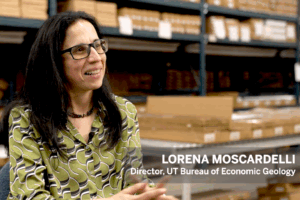The Texas Advanced Computing Center (TACC) has unveiled one of the most powerful visualization environments in the world in a newly transformed laboratory space on The University of Texas at Austin’s main campus.
The ACES Visualization Laboratory, a 2,900-square-foot environment on the ground floor of the Advanced Computational Engineering and Sciences (ACES) building, is available for researchers who use scientific visualization as part of the discovery process in their research.
“A tremendous wealth of treasures benefiting the sciences, the humanities, and the arts can be found across our campus at The University of Texas at Austin,” said President William Powers Jr. “TACC’s new Visualization Lab is without question one of the crown jewels among these treasures. It is one of the highlights on the tour of our resources and facilities–but beyond the obvious ‘wow’ factor visitors enjoy, the lab is indispensible to much of the basic research and groundbreaking scientific exploration conducted on our campus. The results of the work that the Visualization Lab makes possible truly make lives better–now, and for generations to come.”
According to Kelly Gaither, associate director for data and information analysis at TACC, scientific visualization is an essential aspect of doing science today. This process aids understanding by transforming raw data into a logical, visual format allowing scientists in every field to see hidden aspects of their research–patterns, features, relationships and anomalies.
“Having a VisLab of this scale on the UT campus available to the local and national research community is necessary to make UT a leader in data analysis,” Gaither said. “The lab is now capable of reproducing terascale (one trillion bytes) data sets with exceptional clarity and resolution. This new configuration transforms it from a single-user to a multi-user environment.”
Thanks in part to a collaborative grant from Dell Inc., Intel Corporation, Microsoft Corporation and Cisco Systems, TACC built the new lab for about $500,000, providing 10 times the performance of the previous lab–at about one-tenth of the cost. Since the lab uses relatively inexpensive commodity parts, it can be easily upgraded with new processors, commodity graphics cards, or monitors, as the technology advances.
John Mullen, vice president and general manager for Dell’s Education, State and Local Government, said, “Dell is proud of its long-standing relationship with TACC and UT. We share their commitment to providing a fully standardized supercomputing environment that is easily accessible for researchers of all disciplines. We are thrilled to see Stallion in place and ready to power the innovative work that will be taking place in the new Visualization Lab.”
“We’re very excited about Stallion,” Gaither said. “Scientifically, it will benefit anyone who has need for displaying large scale datasets at high fidelity.”
An average desktop displays roughly 1600×1200 pixels of resolution, or almost two megapixels–Stallion has almost 100 times more resolution.
Though experienced researchers in hard sciences like cosmology, physics, geology and engineering will be among the main users of the new resources, the lab is designed for a much broader audience.
“One of the lab’s greatest strengths is the staff expertise and support available to our users,” Gaither said. “The lab will serve as an education and outreach environment, lending itself to a variety of audiences including students and educators, and VIP tours for groups that visit UT.”
“It’s a catalyst to go to the next level of science, much in the same way that TACC’s supercomputers have been a catalyst for going to a new level for scientific simulations, the lab will be a catalyst for developing new kinds of scientific imagery.”
The ACES Visualization Laboratory is available on a reservation basis to researchers at The University of Texas at Austin, The University of Texas System, and to members of the TeraGrid community. For more information, please contact: Faith Singer-Villalobos, 512-232-5771, faith@tacc.utexas.edu.
Technology Highlights
- The lab features Stallion, a 20.5′ x 7.5′ display environment comprising 45 Dell 30-inch flat panel monitors offering 184 million pixels, powered by a cluster of 23 high-end Dell XPS systems and a Dell Precision 690 head node. This configuration allows an extremely high level of detail and quality compared to a typical moderate pixel count projector. With 47 NVIDIA graphics cards, 108 gigabytes of system memory, and more than 36 gigabytes of graphics memory, Stallion enables datasets to process on a massive scale, and allows the interactive visualization of substantial geometries.
- The lab features a Sony Projection System with a 20′ x 11′ display. This configuration provides users with added flexibility to run a wide variety of applications. The projector produces exceptional brightness and a high resolution, nine megapixel viewing area.
- The Dell Workstation Area consists of four high-end Dell workstations complete with large LCD displays. Each workstation provides a single user with the tools for visualization development. Users may develop their visualizations here, and then display them on Stallion or on the Sony Projection System.
- The Collaboration Room offers the opportunity for small groups to work together on developing and exploring visualizations. Users may develop their visualizations on the workstation, and then transition them to one of the two larger display systems.



